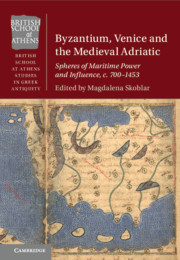Book contents
- Byzantium, Venice and the Medieval Adriatic
- British School at Athens Studies in Greek Antiquity
- Byzantium, Venice and the Medieval Adriatic
- Copyright page
- Contents
- Figures and Maps
- Tables
- Contributors
- Foreword
- Acknowledgements
- Note on Citation, Transliteration, Names, Titles and Dates
- Maps
- Introduction
- 1 The Adriatic Sea 500–1100
- 2 Thinking of Linking
- 3 A Winter Sea?
- 4 The Origins of Venice
- 5 The Northern Adriatic Area between the Eighth and the Ninth Century
- 6 Provincia Iadrensis
- 7 Ravenna and Other Early Rivals of Venice
- 8 Byzantine Apulia
- 9 From One Coast to Another and Beyond
- 10 Icons in the Adriatic before the Sack of Constantinople in 1204
- 11 The Rise of the Adriatic in the Age of the Crusades
- 12 Venice in the Twelfth Century
- 13 Venice, the Ionian Sea and the Southern Adriatic after the Fourth Crusade
- 14 Sea Power and the Evolution of Venetian Crusading
- 15 Reassessing the Venetian Presence in the Late Medieval Eastern Adriatic
- 16 ‘Strangers in the City?’
- Conclusion
- Index
- References
Conclusion
Published online by Cambridge University Press: 26 March 2021
- Byzantium, Venice and the Medieval Adriatic
- British School at Athens Studies in Greek Antiquity
- Byzantium, Venice and the Medieval Adriatic
- Copyright page
- Contents
- Figures and Maps
- Tables
- Contributors
- Foreword
- Acknowledgements
- Note on Citation, Transliteration, Names, Titles and Dates
- Maps
- Introduction
- 1 The Adriatic Sea 500–1100
- 2 Thinking of Linking
- 3 A Winter Sea?
- 4 The Origins of Venice
- 5 The Northern Adriatic Area between the Eighth and the Ninth Century
- 6 Provincia Iadrensis
- 7 Ravenna and Other Early Rivals of Venice
- 8 Byzantine Apulia
- 9 From One Coast to Another and Beyond
- 10 Icons in the Adriatic before the Sack of Constantinople in 1204
- 11 The Rise of the Adriatic in the Age of the Crusades
- 12 Venice in the Twelfth Century
- 13 Venice, the Ionian Sea and the Southern Adriatic after the Fourth Crusade
- 14 Sea Power and the Evolution of Venetian Crusading
- 15 Reassessing the Venetian Presence in the Late Medieval Eastern Adriatic
- 16 ‘Strangers in the City?’
- Conclusion
- Index
- References
Summary
Venice, and then the Adriatic, was the main route to Byzantium for the whole Medieval period, for anyone coming to the former eastern Roman empire from or through northern Italy. The geographical position of the sea makes that inevitable. The west–east sea route via Sicily worked for some Europeans, but only on a large scale after the Normans conquered the island from the Arabs in the late eleventh century and even then less prominently than the Adriatic did; the land route through Hungary, which had a border with Byzantium in the eleventh and twelfth centuries, suited some armies, but it was never an easy passage; and the Danube was underused as a route for a long time. So the Adriatic had a major role as a path to the Byzantine empire in every Medieval century, and this book amply shows what sorts of roles it took, in the sometimes dramatically changing economic and political environments of nine centuries.
- Type
- Chapter
- Information
- Byzantium, Venice and the Medieval AdriaticSpheres of Maritime Power and Influence, c. 700-1453, pp. 385 - 390Publisher: Cambridge University PressPrint publication year: 2021



